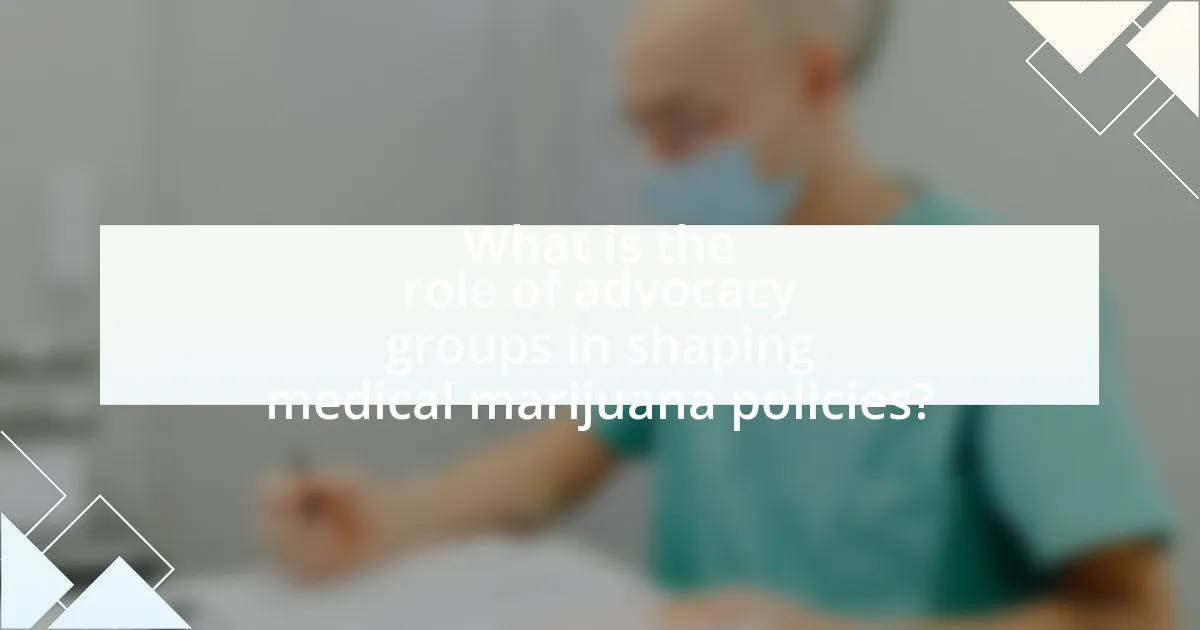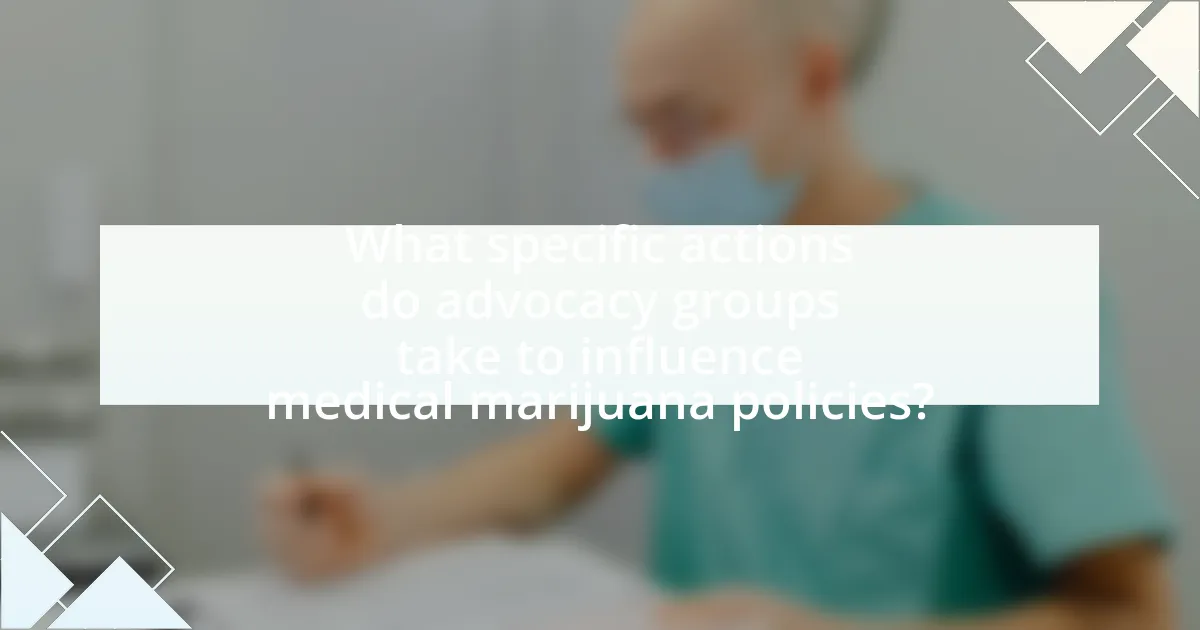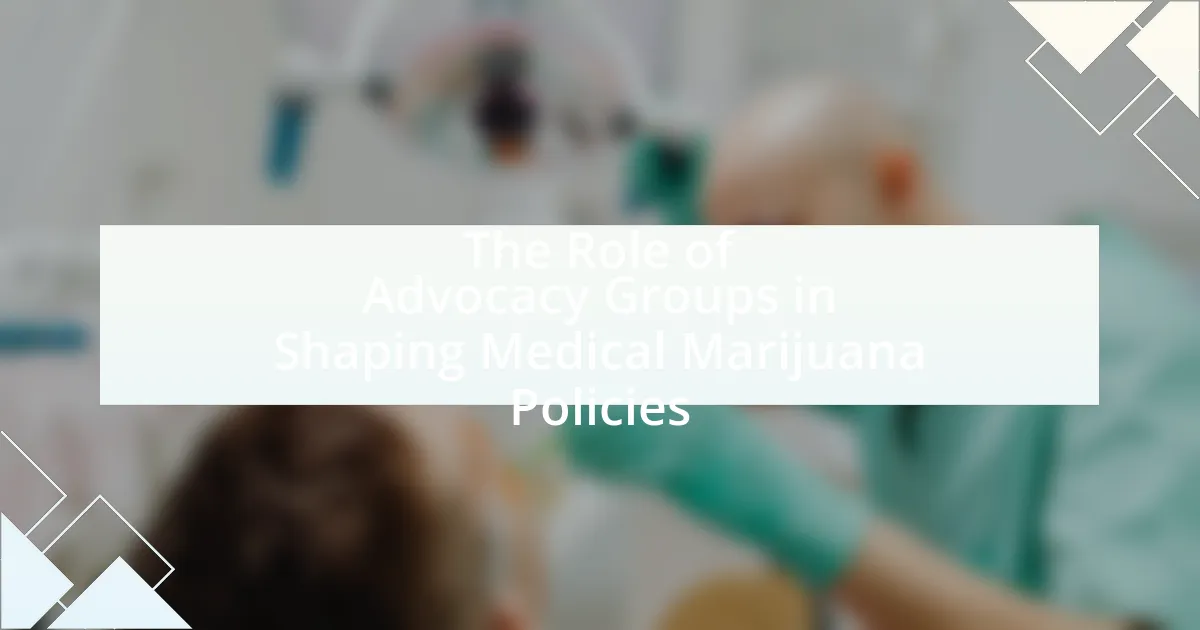Advocacy groups play a pivotal role in shaping medical marijuana policies by mobilizing public support, influencing legislation, and educating stakeholders about the benefits of medical cannabis. These organizations, such as the National Organization for the Reform of Marijuana Laws (NORML) and the Marijuana Policy Project (MPP), utilize strategies like grassroots mobilization, lobbying, and coalition building to promote policy changes at various governmental levels. Their efforts have led to the legalization of medical marijuana in over 30 states, reflecting a significant shift in public perception and legislative action. The article explores the methods, challenges, and successes of these advocacy groups in the context of medical marijuana policy reform.

What is the role of advocacy groups in shaping medical marijuana policies?
Advocacy groups play a crucial role in shaping medical marijuana policies by mobilizing public support, influencing legislation, and providing education on the benefits of medical cannabis. These organizations often conduct research, disseminate information, and engage in lobbying efforts to promote policy changes at local, state, and federal levels. For instance, the National Organization for the Reform of Marijuana Laws (NORML) has been instrumental in advocating for the legalization and regulation of medical marijuana, contributing to the passage of laws in numerous states. Their efforts have led to increased awareness and acceptance of medical marijuana, ultimately impacting legislative decisions and public health policies.
How do advocacy groups influence legislation regarding medical marijuana?
Advocacy groups influence legislation regarding medical marijuana by mobilizing public support, lobbying lawmakers, and providing research and data to inform policy decisions. These organizations often engage in grassroots campaigns to raise awareness about the benefits of medical marijuana, which can shift public opinion and pressure legislators to consider reform. For instance, the National Organization for the Reform of Marijuana Laws (NORML) has been instrumental in advocating for changes in marijuana laws across various states, leading to the legalization of medical marijuana in over 30 states as of 2023. Additionally, advocacy groups often collaborate with medical professionals to present evidence-based arguments that highlight the therapeutic benefits of medical marijuana, thereby strengthening their case for legislative change.
What strategies do advocacy groups use to promote medical marijuana policies?
Advocacy groups promote medical marijuana policies through strategies such as grassroots mobilization, lobbying efforts, public education campaigns, and coalition building. Grassroots mobilization involves organizing community members to participate in rallies, petitions, and local meetings, which helps to demonstrate public support for medical marijuana initiatives. Lobbying efforts focus on directly influencing lawmakers by providing them with research, personal testimonies, and data that highlight the benefits of medical marijuana for patients. Public education campaigns aim to inform the general public and policymakers about the medical uses of marijuana, often utilizing social media, informational websites, and community events to disseminate accurate information. Coalition building involves forming alliances with other organizations, including health professionals and patient advocacy groups, to create a unified front that amplifies their message and increases their influence in the legislative process. These strategies have been effective in various states, leading to the legalization of medical marijuana in over 30 states in the U.S. as of 2023.
How do advocacy groups mobilize public support for medical marijuana?
Advocacy groups mobilize public support for medical marijuana by employing strategic communication, grassroots organizing, and coalition-building efforts. These groups utilize social media campaigns to disseminate information about the benefits of medical marijuana, reaching a broad audience and fostering community engagement. For instance, organizations like the Marijuana Policy Project have successfully influenced public opinion by sharing personal stories of patients who have benefited from medical marijuana, thereby humanizing the issue. Additionally, advocacy groups often collaborate with healthcare professionals and researchers to provide credible evidence supporting medical marijuana’s efficacy, which bolsters their arguments. According to a 2021 Gallup poll, 68% of Americans support legalizing marijuana, reflecting the effectiveness of these mobilization strategies in shaping public perception and policy.
Why are advocacy groups important in the context of medical marijuana?
Advocacy groups are important in the context of medical marijuana because they influence policy changes and public perception. These organizations mobilize support for legalization, educate the public about the benefits of medical marijuana, and provide a voice for patients who may not have access to treatment options. For instance, the National Organization for the Reform of Marijuana Laws (NORML) has played a significant role in advocating for legislative changes across various states, leading to the legalization of medical marijuana in over 30 states as of 2023. Their efforts help to dismantle stigma, promote research, and ensure that patients receive the care they need.
What impact do advocacy groups have on public perception of medical marijuana?
Advocacy groups significantly influence public perception of medical marijuana by promoting awareness, education, and policy change. These organizations often engage in campaigns that highlight the therapeutic benefits of medical marijuana, countering stigma and misinformation. For instance, studies have shown that states with active advocacy groups tend to have higher public support for medical marijuana legalization, as evidenced by a 2018 survey from the Pew Research Center, which indicated that 62% of Americans support legalizing marijuana, a shift attributed to increased advocacy efforts. Additionally, advocacy groups provide resources and personal testimonials that humanize the issue, making it more relatable and acceptable to the general public.
How do advocacy groups contribute to the education of policymakers about medical marijuana?
Advocacy groups contribute to the education of policymakers about medical marijuana by providing research, expert testimony, and real-world patient experiences. These organizations often compile and disseminate scientific studies that highlight the medical benefits and risks associated with marijuana use, thereby informing legislative discussions. For instance, the National Organization for the Reform of Marijuana Laws (NORML) has published extensive reports that detail the therapeutic effects of cannabis, which have been referenced in policy debates. Additionally, advocacy groups facilitate meetings and forums where healthcare professionals and patients can share firsthand accounts of medical marijuana’s impact, helping to humanize the issue for lawmakers. This combination of data-driven insights and personal narratives equips policymakers with a comprehensive understanding of medical marijuana, ultimately influencing their decisions on related legislation.
What challenges do advocacy groups face in shaping medical marijuana policies?
Advocacy groups face significant challenges in shaping medical marijuana policies, primarily due to legal and regulatory hurdles. These groups often encounter opposition from established political entities and law enforcement agencies that may view medical marijuana with skepticism, complicating efforts to promote policy change. Additionally, the stigma surrounding marijuana use persists, which can hinder public support and legislative progress. For instance, despite growing acceptance, only 38 states have legalized medical marijuana as of 2023, indicating that advocacy efforts must overcome entrenched societal and political barriers. Furthermore, advocacy groups often struggle with limited funding and resources, which restricts their ability to mobilize effectively and influence policymakers.
How do legal and political obstacles affect advocacy efforts?
Legal and political obstacles significantly hinder advocacy efforts by restricting the ability of groups to influence policy and mobilize support. For instance, stringent regulations on lobbying and campaign financing can limit the resources available to advocacy organizations, thereby reducing their effectiveness in promoting medical marijuana policies. Additionally, political opposition from lawmakers who may have vested interests or ideological disagreements can stifle legislative progress, as seen in states where medical marijuana initiatives face repeated legislative blockades. These obstacles create an environment where advocacy groups struggle to gain traction, ultimately impeding their capacity to effect change in medical marijuana legislation.
What role does funding play in the effectiveness of advocacy groups?
Funding is crucial for the effectiveness of advocacy groups as it directly influences their capacity to mobilize resources, conduct research, and engage in outreach activities. Adequate funding allows these groups to hire skilled personnel, develop comprehensive campaigns, and maintain sustained advocacy efforts, which are essential for influencing policy changes. For instance, a study by the Center for American Progress found that advocacy organizations with higher funding levels were more successful in achieving legislative goals, demonstrating a clear correlation between financial resources and advocacy outcomes.
How do advocacy groups collaborate with other stakeholders in the medical marijuana space?
Advocacy groups collaborate with other stakeholders in the medical marijuana space by forming coalitions, engaging in joint lobbying efforts, and participating in public education campaigns. These collaborations often include partnerships with healthcare professionals, legal experts, and patient advocacy organizations to promote policy changes that support medical marijuana access. For instance, the National Organization for the Reform of Marijuana Laws (NORML) frequently works alongside medical associations to advocate for legislation that recognizes the therapeutic benefits of cannabis, thereby enhancing the credibility of their claims. Additionally, advocacy groups utilize data from studies, such as those published in the Journal of Pain Research, to substantiate their positions and influence policymakers effectively.
What are the key advocacy groups involved in medical marijuana policy reform?
Key advocacy groups involved in medical marijuana policy reform include the National Organization for the Reform of Marijuana Laws (NORML), the Marijuana Policy Project (MPP), and Americans for Safe Access (ASA). NORML has been instrumental in advocating for the legalization and reform of marijuana laws since its founding in 1970, focusing on legislative change and public education. The MPP, established in 1995, works to change marijuana laws at both the state and federal levels, emphasizing the need for medical access. ASA, founded in 2002, specifically advocates for patients’ rights to access medical cannabis and has played a significant role in shaping policies that protect those rights. These organizations collectively influence legislation and public perception regarding medical marijuana.

What specific actions do advocacy groups take to influence medical marijuana policies?
Advocacy groups influence medical marijuana policies through lobbying, public education campaigns, and grassroots mobilization. These organizations engage in lobbying by meeting with lawmakers to advocate for specific legislation, often providing research and data to support their positions. For example, the National Organization for the Reform of Marijuana Laws (NORML) has actively lobbied for the legalization of medical marijuana in various states, contributing to policy changes. Additionally, advocacy groups conduct public education campaigns to raise awareness about the benefits of medical marijuana, utilizing social media, informational seminars, and community outreach to inform the public and policymakers. Grassroots mobilization involves organizing rallies, petitions, and community events to demonstrate public support for medical marijuana initiatives, which can sway legislative decisions. Collectively, these actions have led to significant shifts in medical marijuana policies across numerous states.
How do advocacy groups engage with lawmakers and government officials?
Advocacy groups engage with lawmakers and government officials through direct lobbying, grassroots mobilization, and strategic partnerships. These groups often employ lobbyists to communicate their positions on medical marijuana policies, providing lawmakers with research, data, and personal stories that illustrate the benefits or challenges of such policies. For instance, the National Organization for the Reform of Marijuana Laws (NORML) has actively lobbied for legislative changes by presenting evidence-based arguments and mobilizing public support to influence decision-makers. Additionally, advocacy groups organize campaigns that encourage constituents to contact their representatives, thereby amplifying their message and demonstrating public backing for specific legislative initiatives.
What methods do advocacy groups use to present their case to legislators?
Advocacy groups use various methods to present their case to legislators, including direct lobbying, grassroots mobilization, and the dissemination of research and data. Direct lobbying involves meeting with legislators to discuss specific policies, providing them with tailored information and arguments that support the group’s position. Grassroots mobilization engages the public to contact their representatives, amplifying the advocacy group’s message and demonstrating widespread support for medical marijuana policies. Additionally, advocacy groups often present research findings and data to substantiate their claims, highlighting the medical benefits of marijuana and its impact on public health, which can influence legislative decisions. For example, studies have shown that states with medical marijuana laws report lower opioid overdose rates, providing concrete evidence that can sway lawmakers.
How do advocacy groups track and respond to legislative changes?
Advocacy groups track and respond to legislative changes by utilizing a combination of monitoring tools, legislative databases, and grassroots mobilization strategies. These organizations often subscribe to legislative tracking services that provide real-time updates on bills and policy proposals relevant to their interests, such as medical marijuana legislation. For instance, groups like the National Organization for the Reform of Marijuana Laws (NORML) employ tools like the National Conference of State Legislatures (NCSL) database to stay informed about state-level legislative developments.
In response to identified changes, advocacy groups mobilize their members and the public through campaigns, petitions, and lobbying efforts to influence lawmakers. They may also produce position papers and engage in public education initiatives to shape public opinion and encourage legislative support. This proactive approach is evidenced by the significant increase in medical marijuana legalization across various states, driven in part by organized advocacy efforts that respond swiftly to legislative shifts.
What role do grassroots movements play in advocacy for medical marijuana?
Grassroots movements play a crucial role in advocating for medical marijuana by mobilizing community support, raising awareness, and influencing policy change. These movements often consist of individuals and local organizations that work collectively to educate the public about the benefits of medical marijuana, share personal stories, and challenge existing legal frameworks. For instance, the successful legalization of medical marijuana in states like California in 1996 was largely driven by grassroots efforts, including campaigns led by organizations such as the California Cannabis Initiative. These movements utilize petitions, rallies, and social media to amplify their message, demonstrating significant public support, which can sway lawmakers and lead to legislative changes.
How do grassroots campaigns differ from larger advocacy organizations?
Grassroots campaigns primarily rely on community involvement and local engagement, while larger advocacy organizations often utilize established networks and resources for broader outreach. Grassroots campaigns focus on mobilizing individuals at the local level to advocate for change, often emphasizing personal stories and direct action, which can lead to significant local impact. In contrast, larger advocacy organizations typically have more funding, staff, and access to political connections, allowing them to influence policy on a national or state level through lobbying and strategic partnerships. For example, organizations like the National Organization for the Reform of Marijuana Laws (NORML) operate on a larger scale, employing professional lobbyists and extensive media campaigns, whereas grassroots movements may organize local events and community discussions to raise awareness and support for medical marijuana policies.
What successes have grassroots movements achieved in medical marijuana policy reform?
Grassroots movements have successfully influenced medical marijuana policy reform by advocating for legalization and access to medical cannabis across various states. For instance, in 1996, California became the first state to legalize medical marijuana through Proposition 215, largely driven by grassroots efforts from organizations like the Cannabis Action Network. Additionally, grassroots campaigns have led to the passage of medical marijuana laws in over 30 states, including significant victories in states like Colorado and Illinois, where public support was mobilized through community outreach and education. These movements have also played a crucial role in shaping public opinion, resulting in increased acceptance and legislative changes, as evidenced by a 2021 Gallup poll showing that 68% of Americans support legalizing marijuana for medical use.

What are the outcomes of advocacy group efforts in medical marijuana policy development?
Advocacy group efforts in medical marijuana policy development have led to significant legislative changes, including the legalization of medical marijuana in numerous states. For instance, as of 2023, 38 states and the District of Columbia have enacted laws allowing for medical marijuana use, largely influenced by advocacy campaigns that raised public awareness and mobilized support. These groups have effectively lobbied lawmakers, resulting in the introduction and passage of bills that reflect public demand for access to medical cannabis for various health conditions, such as chronic pain and epilepsy. Additionally, advocacy organizations have played a crucial role in shaping public opinion through educational initiatives, which have contributed to the destigmatization of medical marijuana and increased acceptance among healthcare professionals and the general public.
How have advocacy groups successfully changed medical marijuana laws?
Advocacy groups have successfully changed medical marijuana laws by mobilizing public support, influencing policymakers, and providing research-based evidence of medical benefits. For instance, organizations like the National Organization for the Reform of Marijuana Laws (NORML) have conducted campaigns that raise awareness about the therapeutic uses of cannabis, leading to increased public acceptance. This public support has pressured legislators to reconsider existing laws, resulting in states like California legalizing medical marijuana in 1996, which set a precedent for other states. Additionally, advocacy groups have collaborated with medical professionals to present data showing the efficacy of marijuana in treating conditions such as chronic pain and epilepsy, further legitimizing their claims and prompting legislative changes.
What case studies illustrate successful advocacy for medical marijuana policies?
Case studies illustrating successful advocacy for medical marijuana policies include the efforts of the Marijuana Policy Project (MPP) in various states, particularly in California and Colorado. In California, MPP played a crucial role in the passage of Proposition 215 in 1996, which was the first state law to allow medical marijuana use, demonstrating effective grassroots mobilization and legislative lobbying. In Colorado, MPP’s advocacy contributed to the successful implementation of Amendment 20 in 2000, establishing a regulated medical marijuana program. These case studies highlight how organized advocacy efforts can lead to significant policy changes, supported by public opinion shifts and legislative action.
What metrics can be used to measure the success of advocacy efforts?
Metrics used to measure the success of advocacy efforts include changes in legislation, public opinion shifts, engagement levels, and funding increases. Changes in legislation can be quantified by the number of laws passed or amended that align with advocacy goals, such as the legalization of medical marijuana in various states. Public opinion shifts can be assessed through surveys indicating increased support for medical marijuana policies, reflecting the effectiveness of advocacy campaigns. Engagement levels can be measured by tracking participation in advocacy events, social media interactions, and the growth of membership in advocacy organizations. Funding increases can be evaluated by the amount of financial support received for advocacy initiatives, which often correlates with successful outreach and influence. These metrics provide concrete evidence of the impact advocacy groups have on shaping medical marijuana policies.
What best practices can advocacy groups adopt to enhance their effectiveness?
Advocacy groups can enhance their effectiveness by employing strategic communication, building coalitions, and utilizing data-driven approaches. Strategic communication involves crafting clear, compelling messages that resonate with target audiences, which is essential for mobilizing support and influencing policy. Building coalitions with other organizations amplifies their voice and resources, as seen in successful campaigns like the legalization of medical marijuana in various states, where diverse groups united for a common cause. Utilizing data-driven approaches, such as presenting research on the benefits of medical marijuana, strengthens their arguments and provides credible evidence to policymakers, as demonstrated by studies showing reduced opioid prescriptions in states with medical marijuana laws.
How can advocacy groups build coalitions to strengthen their influence?
Advocacy groups can build coalitions to strengthen their influence by identifying common goals and aligning their missions with like-minded organizations. This collaborative approach allows groups to pool resources, share expertise, and amplify their collective voice, which is crucial in influencing policy decisions. For instance, the National Organization for the Reform of Marijuana Laws (NORML) has successfully partnered with various health organizations and civil rights groups to advocate for medical marijuana legislation, demonstrating the effectiveness of coalition-building in achieving legislative change. By leveraging diverse perspectives and mobilizing a broader base of support, advocacy groups can enhance their impact on medical marijuana policies.
What communication strategies are most effective for advocacy groups?
Effective communication strategies for advocacy groups include storytelling, social media engagement, coalition building, and targeted messaging. Storytelling allows advocacy groups to connect emotionally with their audience, making complex issues relatable and memorable. Social media engagement enables real-time interaction and broadens reach, as evidenced by the American Civil Liberties Union’s successful campaigns that utilized platforms like Twitter and Facebook to mobilize support. Coalition building fosters partnerships with other organizations, amplifying voices and resources, which has been shown to enhance advocacy efforts, such as the collaboration between various health organizations to promote medical marijuana policies. Targeted messaging ensures that communications resonate with specific demographics, increasing the likelihood of influencing public opinion and policy decisions.
What future trends can be anticipated for advocacy groups in medical marijuana policy?
Future trends for advocacy groups in medical marijuana policy include increased collaboration with healthcare professionals and a focus on evidence-based research to support policy changes. As public acceptance of medical marijuana grows, advocacy groups are likely to leverage partnerships with medical associations to promote clinical studies that demonstrate the efficacy of cannabis in treating various conditions. Additionally, advocacy efforts will likely shift towards addressing regulatory challenges and ensuring equitable access to medical marijuana, particularly for marginalized communities. This trend is supported by the growing body of research indicating the therapeutic benefits of medical marijuana, which has prompted calls for more comprehensive policies that reflect scientific findings.

Leave a Reply